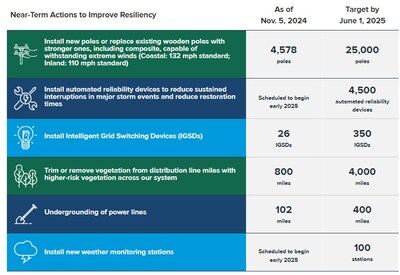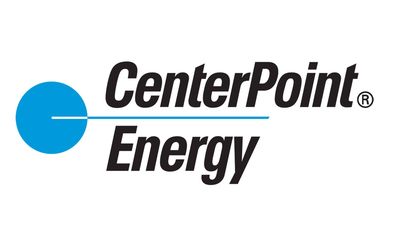Greater Houston Resiliency Initiative Progress Update: CenterPoint Energy Makes Significant Advances on Critical Resiliency Actions
Rhea-AI Summary
CenterPoint Energy has released its first progress update on Phase Two of the Greater Houston Resiliency Initiative (GHRI). In the first two months, the company has installed nearly 4,600 storm-resilient poles, placed over 100 miles of power lines underground, cleared more than 800 miles of hazardous vegetation, and installed self-healing automation devices. The initiative aims to reduce outage minutes by 125 million annually and build the most resilient coastal grid nationwide. Additionally, the company has completed all 42 critical actions committed post-Hurricane Beryl, including trimming vegetation from 2,000+ power line miles and installing 1,100+ storm-resilient poles.
Positive
- Implementation of infrastructure improvements that will reduce annual outage minutes by 125 million
- Completed installation of 4,600 storm-resilient poles and 100+ miles of underground power lines
- Early completion of all 42 post-Hurricane Beryl commitments
- Installation of automated reliability devices to minimize sustained interruptions
Negative
- None.
News Market Reaction 1 Alert
On the day this news was published, CNP gained 0.54%, reflecting a mild positive market reaction.
Data tracked by StockTitan Argus on the day of publication.
Company has installed or replaced nearly 4,600 stronger storm-resilient poles; cleared more than 800 miles of higher-risk vegetation; undergrounded more than 100 miles of power lines; and installed dozens of new, intelligent grid switching devices
"This summer, we accomplished a significant level of increased system hardening in the first phase of the Greater Houston Resilience Initiative. Since then, as we have been fully engaged in delivering the additional set of actions in our second phase of GHRI, we continue to make significant progress as we work toward our ultimate goal of becoming the most resilient coastal grid in the country. Now, and in the months to come, we will remain laser-focused on completing these critical resiliency actions and building the more reliable and more resilient energy system our customers expect and deserve," said Darin Carroll, CenterPoint Energy Senior Vice President of CenterPoint Energy's Electric Business.
GHRI Phase Two: Progress Update
CenterPoint announced on September 30 the launch of Phase Two of the GHRI, which included a series of actions to strengthen resiliency, enable a self-healing grid and reduce the duration and impact of power outages. Through early November, significant progress has been made across its service area, including:
GHRI Phase Two: Looking Ahead
As part of the second phase of GHRI, which runs through May 31, 2025, CenterPoint teams will be taking additional actions including: installing 4,500 automated reliability devices to minimize sustained interruptions during major storm events and reduce restoration times; and establishing a network of 100 new weather monitoring stations. This part of GHRI Phase Two is set to begin in early 2025. The company plans to complete each of these actions before the start of the next hurricane season.
When completed, the actions outlined as part of GHRI Phase Two will lead to more than 125 million fewer outage minutes annually for customers. The company is also continuing to expand and improve the way it communicates with customers and engages with communities before, during and after emergencies, including through a year-round safety and preparedness campaign.
Post-Beryl Commitments: Completed Ahead of Schedule
In addition to this Phase Two GHRI work, CenterPoint announced last week that it has completed all 42 of the critical actions the company committed to taking in the aftermath of Hurricane Beryl to immediately strengthen the electric system and improve its storm response. These initial improvements included:
- Trimming or removing higher-risk vegetation from more than 2,000 power line miles
- Installing more than 1,100 stronger, more storm-resilient poles
- Installing more than 300 automated devices to reduce sustained outages
- Launching a new, cloud-based outage tracker
- Improving CenterPoint's Power Alert Service to provide better customer information
- Hosting listening sessions across the service area and using feedback to inform the company's storm response plans
CenterPoint will continue to provide updates on its progress toward completing all of its GHRI commitments. For more information and real-time updates, visit CenterPointEnergy.com/TakingAction.
###
About CenterPoint Energy, Inc.
As the only investor-owned electric and gas utility based in
Forward-looking Statements
This news release, as well as the website pages related to the GHRI, includes forward-looking statements within the meaning of the Private Securities Litigation Reform Act of 1995. When used in this news release or the website pages related to the GHRI, the words "anticipate," "believe," "continue," "could," "estimate," "expect," "forecast," "goal," "intend," "may," "objective," "plan," "potential," "predict," "projection," "should," "target," "will" or other similar words are intended to identify forward-looking statements. These forward-looking statements, which include statements regarding our resiliency investments, and the GHRI, including effectiveness, timing and related matters, are based upon assumptions of management which are believed to be reasonable at the time made and are subject to significant risks and uncertainties. Actual events and results may differ materially from those expressed or implied by these forward-looking statements. Any statements in this news release or the website pages related to the GHRI regarding future events that are not historical facts are forward-looking statements. Each forward-looking statement contained in this news release, or the website pages related to the GHRI speaks only as of the date of this release. Important factors that could cause actual results to differ materially from those indicated by the provided forward-looking information include risks and uncertainties relating to: (1) the impact of pandemics, including the COVID-19 pandemic; (2) financial market conditions; (3) general economic conditions; (4) the timing and impact of future regulatory and legislative decisions; and (5) other factors, risks and uncertainties discussed in CenterPoint Energy's Annual Report on Form 10-K for the fiscal year ended December 31, 2023 and CenterPoint's Quarterly Reports on Form 10-Q for the quarters ended March 31, 2024 and June 30, 2024 and other reports CenterPoint Energy or its subsidiaries may file from time to time with the Securities and Exchange Commission.
For more information, contact:
Communications
Media.Relations@CenterPointEnergy.com
![]() View original content to download multimedia:https://www.prnewswire.com/news-releases/greater-houston-resiliency-initiative-progress-update-centerpoint-energy-makes-significant-advances-on-critical-resiliency-actions-302310688.html
View original content to download multimedia:https://www.prnewswire.com/news-releases/greater-houston-resiliency-initiative-progress-update-centerpoint-energy-makes-significant-advances-on-critical-resiliency-actions-302310688.html
SOURCE CenterPoint Energy, Inc









